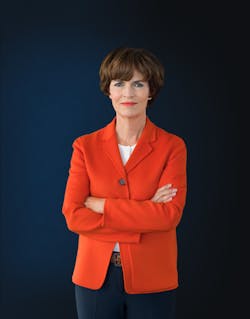Trumpf reports higher sales, but a decline in orders received
Trumpf recorded a renewed increase in sales in the 2018/19 fiscal year that ended June 30, 2019, while orders received and profits declined. Sales rose by 6.1 percent to 3.78 billion euros (3.57 billion euros in the 2017/18 fiscal year). Orders received decreased to 3.68 billion euros (3.80 billion euros in the 2017/18 fiscal year). This equals a reduction of 3.1 percent. Earnings before interest and taxes (EBIT) amounted to 349.3 million euros, which was 34.7 percent below the prior year figure (fiscal year 2017/18: 534.7 million euros). The EBIT margin was 9.2 percent (fiscal year 2017/18: 15.0 percent).
In addition to the high backlog of orders from the previous year, the expansion of the EUV business field was a key driver of the organization's growth in sales revenue. The company supplies special lasers to ASML, a customer in the Netherlands. These lasers are integrated into systems that use extreme ultraviolet radiation to expose chip surfaces for the computer industry. Sales revenue from this business climbed from 0.26 billion euros in the previous year to 0.39 billion euros in the year under review, an increase of 48 percent. EUV consequently accounted for a significant share of Group revenues.
The Machine Tools and Laser Technology business divisions were, by contrast, unable to maintain the high growth rates achieved in the previous year. Revenues for the Machine Tools division rose by a slight 1.2 percent to 2.39 billion euros (previous year: 2.36 billion euros). The Laser Technology division posted revenues of 1.38 billion euros, marginally (-2.1 percent) below the prior-year level of 1.41 billion euros. This decline was attributable to the slowing market in Asia (in particular in China and South Korea) as well as to the automotive industry’s reluctance to invest.
Nicola Leibinger-Kammüller, Trumpf President and Chairwoman of the Managing Board, explains: “As a company operating in the investment goods sector, we are particularly exposed to the impact of cyclical highs and lows. That is currently the case. Given the uncertainty due to the U.S.–China trade conflict and the structural change in the automotive industry, many customers have become more cautious and are postponing investments.”
As in the previous years, Germany was the largest individual market for Trumpf with sales of 721 million euros, up 0.2 percent compared to the previous year (719 million euros). Sales revenue in the United States, the company’s second-biggest market, grew by 23.2 percent to 547 million euros (previous year: 444 million euros). At around 460 million euros, the Netherlands is the third-biggest individual market due to the good development of EUV business, followed by China at 415 million euros (previous year: 457 million euros).
Group-wide, the Trumpf workforce grew by 8 percent from 13,420 to 14,490 employees in 2018/19. There were 7,427 people employed in Germany as at June 30, 2019 (previous year: 6,778), with around 4,400 working at the Ditzingen headquarters. The number of employees outside Germany rose by 6.3 percent to 7,063 (previous year: 6,642).
In the year under review, 485 young people completed a training course or co-op work-study program (previous year: 450). The Group’s training rate was 3.4 percent (previous year: 3.5 percent). There were two reasons for this development: first, continuing growth in employee numbers; second, the incipient shortage of qualified staff in the market, especially in the STEM professions.
After a strong rise in the previous year, investments increased yet again – by 33.3 percent to 288 million euros (previous year: 216 million euros) – in line with the company’s growth strategy. More than half of this expenditure concerned projects in Germany. Construction projects, the majority of which are being carried out at the headquarters in Ditzingen, accounted for in excess of 70 million euros. Completed projects included a lightweight hall, which is being used for the EUV business field, and a daycare center for employees’ children.
Trumpf further pursued its strategy to enhance its technological expertise with new acquisitions. Effective April 1, 2019, Trumpf completed the acquisition of Photonics GmbH from Philips, which it had announced in December 2018. As of the same date, the company set up a new business field, Trumpf Photonic Components. In May 2019, Trumpf acquired the remaining shares in the Chinese subsidiary JFY and now owns the company outright. To reflect this change, Trumpf introduced a new organizational structure with a CEO China.
Trumpf aims to achieve a CO2-neutral energy balance at its production sites worldwide by the end of 2020 and therefore intends to increase investments in measures to protect the climate. By its own reckoning, the company currently emits around 90,000 metric tons of CO2 worldwide per year. Of this amount, 80 percent is accounted for by electricity consumption. In this area, the company is pursuing a policy of concluding further green power contracts and purchasing certificates under carbon trading schemes to offset emissions from the combustion of heating oil, natural gas and other fossil fuels. A similar approach is being applied in markets with limited availability of renewable energies in the electricity mix. All sites in Germany already cover 100 percent of their electricity needs through green power contracts. Worldwide, 60 percent of the electricity needs are covered by green power contracts.
Between now and June 2021, in addition to efforts to close this gap and become 100% green, if necessary by purchasing certificates, the company intends to invest some 6.4 million euros in improving energy efficiency, for example by using its own cogeneration or photovoltaic plants to generate electricity. Other areas of improvement include process optimization, generation and distribution of cooling energy, lighting systems, and systems for the generation, recovery and distribution of heat. In the medium term, Trumpf aims to significantly reduce its use of emissions trading certificates.
Source: Trumpf
